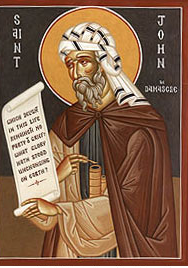Saint of the Day Online - St John of Damascus
Saint of the day online, Sunday, December 04, 2017
04-12-2017
Saint Name: Damascus, Bilad al-Sham, Umayyad Caliphate
Place: Damascus, Bilad al-Sham, Umayyad Caliphate
Birth: 676
Death:749
Feast: December 04
Saint John of Damascus who was born on c. 675 or 676 as a Syrian monk and priest. Born and raised in Damascus, he died at his monastery, Mar Saba, near Jerusalem.
The ancestors of John, according to his biographer, when Damascus fell into the hands of the Arabs, had alone remained faithful to Christianity. They commanded the respect of the conqueror, and were employed in judicial offices of trust and dignity, to administer, no doubt, the Christian law to the Christian subjects of the Sultan. His father, besides this honorable rank, had amassed great wealth; all this he devoted to the redemption of Christian slaves on whom he bestowed their freedom. John was the reward of these pious actions. John was baptized immediately on his birth, probably by Peter II, bishop of Damascus, afterwards a sufferer for the Faith. The father was anxious to keep his son aloof from the savage habits of war and piracy, to which the youths of Damascus were addicted, and to devote him to the pursuit of knowledge. The Saracen pirates of the seashore neighboring to Damascus, swept the Mediterranean, and brought in Christian captives from all quarters.
A monk named Cosmas had the misfortune to fall into the hands of these freebooters. He was set apart for death, when his executioners, Christian slaves no doubt, fell at his feet and entreated his intercession with the Redeemer. The Saracens enquired of Cosmas who he was. He replied that he had not the dignity of a priest; he was a simple monk, and burst into tears. The father of John was standing by, and expressed his surprise at this exhibition of timidity. Cosmas answered, "It is not for the loss of my life, but of my learning, that I weep." Then he recounted his attainments, and the father of John, thinking he would make a valuable tutor for his son, begged or bought his life of the Saracen governor; gave him his freedom, and placed his son under his tuition. The pupil in time exhausted all the acquirements of his teacher. The monk then obtained his dismissal, and retired to the monastery of S. Sabas, where he would have closed his days in peace, had he not been compelled to take on himself the bishopric of Majuma, the port of Gaza.
John had at least one and possibly two careers: one (less well-documented) as a civil servant for the Caliph in Damascus, and the other (better-attested) as a priest and monk at the Mar Saba monastery near Jerusalem. One source believes John left Damascus to become a monk around 706, when al-Walid I increased the Islamicisation of the Caliphate's administration. However, Muslim sources only mention that his father Sarjun (Sergius) left the administration around this time, and fail to name John at all.[18] During the next two decades, culminating in the Siege of Constantinople (717-718), the Umayyad Caliphate progressively occupied the borderlands of the Byzantine Empire. An editor of John's works, Father Le Quien, has shown that John was already a monk at Mar Saba before the dispute over iconoclasm, explained below.
In the early 8th century AD, iconoclasm, a movement opposed to the veneration of icons, gained acceptance in the Byzantine court. In 726, despite the protests of St. Germanus, Patriarch of Constantinople, Emperor Leo III (who had forced the emperor to abdicate and himself assumed the throne in 717 immediately before the great siege) issued his first edict against the veneration of images and their exhibition in public places.
All agree that John of Damascus undertook a spirited defence of holy images in three separate publications. The earliest of these works, his "Apologetic Treatises against those Decrying the Holy Images", secured his reputation. He not only attacked the Byzantine emperor, but adopted a simplified style that allowed the controversy to be followed by the common people, stirring rebellion among the iconoclasts. Decades after his death, John's writings would play an important role during the Second Council of Nicaea (787), which convened to settle the icon dispute.[citation needed]
John's biography recounts at least one episode deemed improbable or legendary.Leo III reportedly sent forged documents to the caliph which implicated John in a plot to attack Damascus. The caliph then ordered John's right hand be cut off and hung up in public view. Some days afterwards, John asked for the restitution of his hand, and prayed fervently to the Theotokos before her icon: thereupon, his hand is said to have been miraculously restored. In gratitude for this miraculous healing, he attached a silver hand to the icon, which thereafter became known as the "Three-handed", or Tricheirousa.
John died in 749 as a revered Father of the Church, and is recognized as a saint. He is sometimes called the last of the Church Fathers by the Roman Catholic Church. In 1890 he was declared a Doctor of the Church by Pope Leo XIII.
Copyright 2017 Grace Ministry Mangalore. Any unauthorized use, without prior written consent of Grace Ministry is strictly forbidden and prohibited.